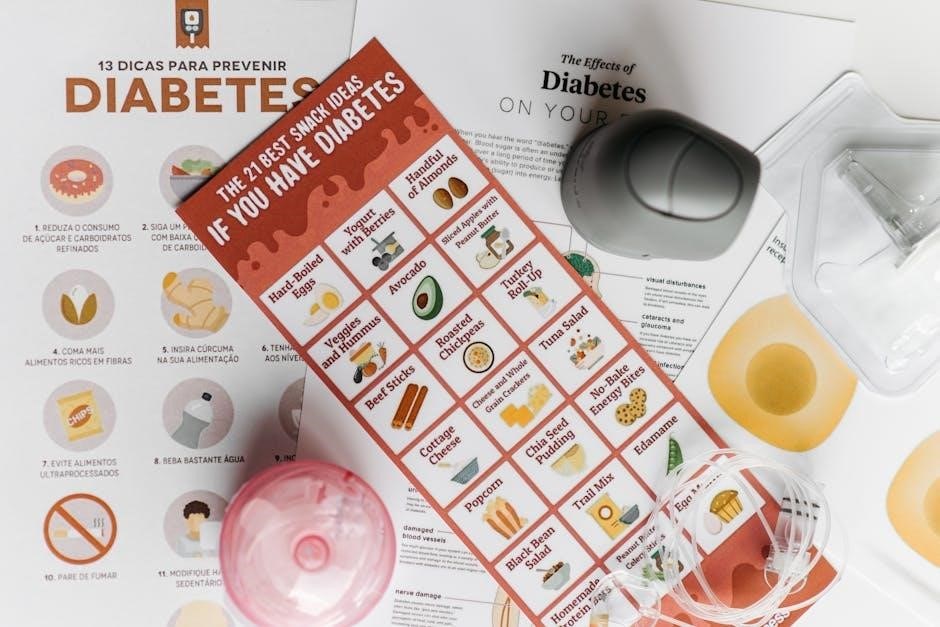Tubular support bandages provide compression and stability for injuries, sprains, and post-surgical care․ They come in various sizes to ensure proper fit and effectiveness for different body parts․
What Are Tubular Support Bandages?
Tubular support bandages are versatile medical tools designed to provide compression and stability for injured limbs․ Made from elastic materials, they offer firm support for sprains, strains, and swelling while allowing for easy application and reapplication․ These bandages are commonly used for treating edema, sprains, and post-surgical care, ensuring steady compression without restricting blood circulation․ Unlike traditional bandages, tubular support bandages do not require pins, tape, or fasteners, making them convenient and user-friendly․ They are available in various sizes to accommodate different body parts, from small limbs like fingers to larger areas such as thighs․ Their elastic nature allows for custom compression, making them reusable and adaptable to individual needs․ Tubular bandages are a popular choice for both medical and athletic use due to their comfort and effectiveness․
Common Uses of Tubular Support Bandages
Tubular support bandages are widely used for providing compression and stability to injured or swollen body parts․ They are commonly employed in treating sprains, strains, and minor fractures, as well as managing swelling and edema․ These bandages are also popular for post-surgical care to support healing tissues and reduce discomfort․ Athletes often use them to provide joint support during physical activities, preventing injuries and offering relief during recovery․ Additionally, tubular bandages are used for chronic conditions like arthritis to reduce pain and inflammation․ Their versatility allows them to be applied to various body parts, including knees, elbows, wrists, and ankles, making them a essential tool for both medical and sports-related needs․

Key Considerations for Choosing the Right Size
Choosing the right size involves ensuring proper fit, understanding sizing charts, and accurate measurements․ Different body parts and compression levels also influence selection․ Intended use matters․
Understanding the Importance of Proper Fit
A proper fit is essential for maximizing comfort and effectiveness․ Tubular support bandages that are too tight can restrict movement or cause discomfort, while those that are too loose may fail to provide adequate support․ Achieving the right fit ensures optimal compression, promoting healing and reducing the risk of complications․ Properly fitted bandages also prevent bunching or rolling, which can lead to skin irritation․ Accurate sizing is critical for maintaining consistent compression levels, especially for individuals with specific medical conditions or athletic needs․ Incorrect sizing can compromise the bandage’s functionality, making it less effective in providing the necessary support or stability․ Always prioritize proper fit to ensure the best outcomes for recovery or performance․
Measuring Techniques for Accurate Sizing
Accurate sizing begins with precise measurements․ Use a flexible tape measure to determine the circumference of the body part requiring support․ Measure the thickest part of the limb or area, ensuring the tape is snug but not overly tight․ For limbs like arms or legs, measure at the midpoint between the joint and the knee or elbow․ Avoid stretching the bandage during measurement, as this can lead to incorrect sizing․ Always measure in a standing or sitting position, depending on the area, to reflect natural posture․ This ensures the bandage will fit comfortably during daily activities or exercise․
Take multiple measurements to confirm accuracy, especially if the area swells throughout the day․ Comparing these measurements to a sizing chart will help select the ideal fit․ Always follow the manufacturer’s guidelines for specific measuring techniques, as slight variations may exist between brands or models․ Proper measurement is the foundation for optimal support and comfort․
Different Body Parts and Their Sizing Needs
Different body parts require specific sizing considerations for tubular support bandages․ Arms and legs, for instance, vary significantly in circumference and length, so measuring both dimensions is essential․ The upper arm may need a larger size than the forearm, while the thigh often requires a larger size than the calf․ Wrists and ankles, being smaller and more delicate, need precise sizing to avoid restricting movement․ Additionally, the shape of the body part influences fit—straight limbs may differ from joints or tapered areas․ Each region’s unique anatomy and movement patterns dictate the ideal size and compression level․ Understanding these differences ensures the bandage provides the right balance of support and comfort for each area․

Tubular Bandage Sizing Charts
Tubular bandage sizing charts provide standardized size options based on body part circumference, often including length and compression levels to ensure proper fit and support․
General Size Charts for Tubular Bandages
General size charts for tubular bandages are standardized guides that help determine the appropriate size based on body part measurements․ These charts typically categorize sizes from Small to Extra-Large, with specific circumference ranges․ Sizes often range from 4 to 8 inches in width and 30 to 40 inches in length․ Charts vary slightly by manufacturer but generally follow similar size categories․ They are designed to accommodate average limb sizes, ensuring proper fit and compression․ For example, a Small size might suit wrists or ankles, while larger sizes are meant for thighs or torso areas․ Always refer to the chart for precise measurements to ensure optimal support and comfort․ Proper sizing is crucial for effective use․
Brand-Specific Sizing Guides (e․g․, Tubigrip)
Brand-specific sizing guides, such as those provided by Tubigrip, offer tailored size recommendations for their tubular support bandages․ These guides often include detailed charts with specific measurements for different body parts․ Tubigrip, for instance, uses a color-coded system to differentiate sizes, making selection easier․ Sizes typically range from Small to Extra-Large, with each size catering to specific limb circumferences․ For example, a Small Tubigrip bandage might be ideal for wrists or ankles, while larger sizes are designed for thighs or torso areas․ These guides also account for compression levels and fabric stretch, ensuring a precise fit․ Always refer to the manufacturer’s chart for accurate sizing, as variations may exist between brands; Proper fit ensures optimal support and comfort, making brand-specific guides invaluable for users․
How to Read and Interpret Sizing Charts
Reading and interpreting sizing charts for tubular support bandages requires attention to detail to ensure the correct fit․ Most charts are divided into columns, with measurements (e․g․, circumference or length) on one side and corresponding sizes on the other․ Start by identifying the body part you need to measure, then locate the appropriate row or column․ Match the measurement to the size range provided․ Pay attention to whether the chart refers to uncompressed or compressed measurements, as this can affect accuracy․ Some charts may include visual guides or diagrams to help users understand how to align their measurements․ Always double-check the measurements to avoid sizing errors․ Accurate interpretation ensures the bandage provides the right level of support and comfort․

Factors Influencing Size Selection
Body size, injury location, swelling potential, and compression needs are key factors influencing size selection for tubular support bandages․
Compression Levels and Their Impact on Size
Compression levels significantly influence the size selection of tubular support bandages․ Higher compression levels, such as firm or extra-firm, may require a smaller size to avoid excessive tightness, while lower compression levels, like light or medium, may necessitate a larger size for adequate support․ The thickness of the bandage material also plays a role, as denser materials provide greater compression․ Proper measurement ensures the bandage applies even pressure without restricting movement or cutting off circulation․ It’s essential to balance compression needs with comfort to avoid discomfort or potential health risks․ Always consult sizing charts and manufacturer guidelines to match compression levels with the correct size for optimal performance․ Correct sizing ensures effective support and prevents complications․ Proper fit is crucial for therapeutic benefits․ Always prioritize accurate measurement and compression-level alignment․

Length and Width Measurements Explained
Length and width measurements are crucial for selecting the appropriate tubular support bandage․ The length refers to the distance the bandage will cover along the body part, ensuring it wraps around the area adequately without being too long or too short․ The width determines the bandage’s coverage area, varying based on the body part’s size and the level of support needed․ Proper measurements ensure the bandage stays securely in place, providing consistent compression and avoiding discomfort․ Measuring techniques typically involve wrapping a flexible tape measure around the widest part of the limb or area requiring support․ Accurate measurements prevent the bandage from being too tight or too loose, ensuring optimal fit and effectiveness․ Always refer to sizing charts for specific length and width guidelines․ Proper fit enhances comfort and therapeutic benefits․ Correct measurements are essential for maximizing support and minimizing potential issues․
Special Considerations for Different Limbs
Different limbs require tailored approaches when selecting tubular support bandages․ For example, the knee and elbow, which are hinge joints, need bandages that accommodate their complex shapes and movements․ The thigh, being larger and more muscular, may require a wider bandage for adequate support, while the calf might need a longer length to cover the entire area․ Arms and legs differ in terms of weight-bearing and mobility, so their bandages must address these unique demands․ Additionally, bandages for the upper limbs often prioritize flexibility, whereas those for the lower limbs focus on durability and compression․ Specialized sizes ensure optimal fit and functionality, preventing discomfort or restricted movement․ Proper sizing enhances the bandage’s effectiveness for specific limbs․ Always consider the limb’s shape, size, and intended use when selecting a bandage․ This ensures the best possible support and comfort․ Tailored sizing improves outcomes and user satisfaction․

Practical Steps for Measuring
Use a flexible measuring tape to determine circumference․ Ensure a snug fit without restricting movement․ Measure mid-calf for legs and mid-bicep for arms for optimal support․
Measuring the Arm for Tubular Bandages
To accurately measure the arm for tubular bandages, wrap a flexible measuring tape around the mid-bicep area when the arm is relaxed․ Ensure the tape is snug but not restrictive, as this will ensure proper fit and support․ The mid-bicep is typically the widest point of the upper arm, providing a consistent reference for sizing․ Measure in a standing position with the arm slightly bent to account for natural movement․ Note the circumference and compare it to the sizing chart․ For optimal comfort, choose a size that allows for a firm fit without compromising circulation․ Consistency is key, so measure at the same time daily to avoid variations due to swelling or activity levels․ Proper measurement ensures the bandage stays in place and provides the necessary support and compression for recovery or injury prevention․
Measuring the Leg for Tubular Bandages
To measure the leg for tubular bandages, start by identifying the area requiring support․ For the thigh, measure the circumference at the mid-point, midway between the knee and groin, while standing․ The tape should be snug but not constricting․ For the calf, measure the widest part, usually just below the knee․ Ensure the leg is relaxed and slightly bent to account for movement․ Record the circumference and compare it to the sizing chart․ Proper measurement is crucial for optimal fit and support․ Consistency is key, so measure at the same time daily to avoid variations due to swelling or activity levels․ Accurate sizing ensures the bandage stays in place and provides the necessary support and compression for recovery or injury prevention․
Measuring the Wrist and Ankle
Measuring the wrist and ankle for tubular bandages requires precision to ensure a proper fit․ For the wrist, wrap a flexible tape measure around the narrowest part, just above the wrist bone, with the arm straight and palm facing upward․ For the ankle, measure the narrowest circumference above the ankle bone, ensuring the foot is relaxed and slightly lifted․ Take multiple measurements to confirm accuracy, as slight variations can occur․ Consistency is key; measure at the same time daily to account for natural size fluctuations․ Proper sizing ensures the bandage stays securely in place without restricting movement․ If unsure, consult a healthcare professional to avoid improper fit and potential discomfort or constriction․


Application and Fit
Proper application involves rolling the bandage smoothly, applying even tension, and ensuring a snug fit․ Always check for proper circulation and adjust as needed․
How to Apply a Tubular Support Bandage
To apply a tubular support bandage correctly, start by ensuring the bandage is the right size for the limb․ Measure the circumference and length to match the size chart․ Slide the bandage gently over the limb, beginning at the narrowest part and moving upwards․ Ensure the bandage is not twisted and lies flat against the skin․ Apply even pressure, avoiding overly tight or loose areas․ Check for proper circulation by ensuring fingers or toes do not tingle or discolor․ Smooth out any wrinkles or bunching to maintain a uniform fit․ Finally, verify that the bandage feels comfortable and provides the necessary support without restricting movement or circulation․
Ensuring Proper Compression and Support
Proper compression and support are essential for the effectiveness of tubular support bandages․ The bandage should provide a snug fit without being overly tight, as excessive pressure can restrict circulation․ To ensure proper compression, choose a size that matches the circumference of the limb precisely․ The bandage should feel firm but allow for the insertion of a finger between the skin and fabric․ Check for even pressure distribution by smoothing out wrinkles or creases․ Avoid twisting or folding the bandage, as this can create uneven pressure․ If the bandage feels too tight or causes discomfort, it may be too small․ Always verify that the bandage stays in place without rolling or slipping during movement․ Proper fit ensures optimal support and comfort for the intended use;
Common Mistakes to Avoid During Application
When applying tubular support bandages, several mistakes can compromise their effectiveness․ Overstretching the bandage is a common error, as it can lead to reduced elasticity and inadequate support․ Wrapping the bandage too tightly or unevenly can cause discomfort or restrict blood flow․ Another mistake is not aligning the bandage correctly with the body part, resulting in poor coverage or support․ Folding or twisting the bandage during application can create pressure points and reduce its functionality․ Additionally, using a bandage that is too small or too large for the limb can lead to insufficient compression or constant slipping․ Always follow the manufacturer’s instructions and ensure smooth, even wrapping for optimal results and comfort․

Specialized Sizes and Needs
Specialized sizes cater to specific needs, such as athletic use, pediatric requirements, or hypoallergenic options, ensuring optimal support and comfort for diverse applications and sensitivities․
Choosing the Right Size for Athletic Use
Selecting the correct size for athletic use ensures optimal performance and injury prevention․ Athletes often require tubular bandages that provide firm compression without restricting movement․ Measure the affected area during rest and after activity to account for swelling․ For high-motion areas like knees and elbows, choose sizes that allow for a full range of motion․ Consider the thickness and breathability of the fabric to prevent overheating during intense activities․ Always refer to the size chart specific to athletic use, as these may differ from standard sizes․ Proper fit ensures consistent compression, reducing the risk of injury or discomfort during sports and training․
Tubular Bandages for Pediatric Use
Tubular bandages for pediatric use are designed to meet the unique needs of children, ensuring comfort, safety, and proper support․ These bandages are typically made from soft, breathable, and hypoallergenic materials to accommodate sensitive skin․ Sizing is critical, as children’s limbs are smaller and grow rapidly․ Measure the child’s limb carefully, referring to pediatric-specific size charts to ensure a snug yet comfortable fit․ Adjustable sizes are often recommended to allow for growth․ Bright colors or fun designs can make bandages more appealing to kids․ Always prioritize ease of application and removal to minimize discomfort․ Proper fit is essential to prevent irritation or restricted movement, making them ideal for active children․ Regular monitoring of fit is advised as children grow․
Latex-Free and Hypoallergenic Options
Latex-free and hypoallergenic tubular bandages are ideal for individuals with sensitive skin or allergies․ These bandages are made from synthetic materials, such as breathable fabrics or bamboo blends, ensuring comfort and reducing the risk of irritation․ Hypoallergenic options are specifically designed to minimize allergic reactions, making them suitable for prolonged use․ Many brands offer latex-free alternatives that provide the same level of support and compression as traditional bandages․ When choosing hypoallergenic bandages, look for certifications or labels indicating they are free from common allergens․ Proper sizing is still essential to ensure effectiveness and comfort․ These options are a great choice for users with skin sensitivities, providing reliable support without compromising on safety or performance․

Care and Maintenance
Regularly wash tubular bandages with mild detergent to maintain elasticity․ Avoid machine drying; air-dry to preserve shape․ Store in a cool, dry place to prevent degradation․
How to Clean and Reuse Tubular Bandages
Tubular bandages can be cleaned and reused to maintain hygiene and extend their lifespan․ Start by washing them by hand using mild soap and lukewarm water․ Avoid using harsh detergents or bleach, as they may damage the elastic fibers․ Gently agitate the water to remove dirt and sweat, then rinse thoroughly․ After washing, reshape the bandage while it is still damp to maintain its form․ Allow it to air dry in a cool, shaded area, avoiding direct sunlight and heat to prevent degradation․ Do not machine wash or dry, as this can stretch or weaken the material․ Regular cleaning and proper drying ensure optimal reuse and maintain the bandage’s supportive properties․
Storage Tips for Longevity
Proper storage is essential to maintain the quality and longevity of tubular support bandages․ Store them in a cool, dry place away from direct sunlight, as heat and moisture can degrade the elastic fibers․ Ensure the bandages are clean and completely dry before storage to prevent mildew․ Roll them neatly rather than folding to maintain their shape and prevent creasing․ Use a breathable container or drawer to store them, avoiding airtight plastic bags that can trap moisture․ Keep them away from sharp objects or heavy items that could cause damage․ By following these tips, you can extend the lifespan of your tubular bandages and ensure they remain effective for future use․
Choosing the right tubular support bandage size is crucial for optimal support and comfort․ Proper sizing ensures effective compression and prevents discomfort or restricted movement․ Always measure carefully, consider the intended use, and store bandages correctly to maintain their quality․ By following these guidelines, you can ensure the best fit and longevity of your tubular support bandages for enhanced performance and durability․
Proper sizing is essential for effective support and comfort when using tubular bandages․ Always measure accurately, considering compression levels and limb circumference․ Different body parts require specific sizing approaches, and athletic or pediatric needs may demand specialized options․ Ensure a snug fit to avoid discomfort or restricted movement․ Regular cleaning and proper storage extend the bandage’s lifespan․ Correct application techniques are vital for optimal support․ Consider hypoallergenic options if sensitivity is a concern․ By following these guidelines, you can select the right size and maintain its quality for long-term use․ Proper care ensures durability, making tubular bandages a reliable choice for various support needs․
Final Tips for Optimal Use
For optimal use, always apply tubular bandages on clean, dry skin to prevent irritation․ Avoid stretching the bandage excessively during application, as this can lead to reduced elasticity over time․ Regularly inspect for signs of wear, such as fraying or loss of compression, and replace as needed․ Store bandages in a cool, dry place, away from direct sunlight, to maintain their quality․ When reusing, ensure the bandage is completely dry to prevent bacterial growth․ Consider consulting a healthcare professional for custom sizing or specific medical needs․ By following these tips, you can maximize comfort, support, and durability, ensuring your tubular bandages provide long-lasting benefits․
